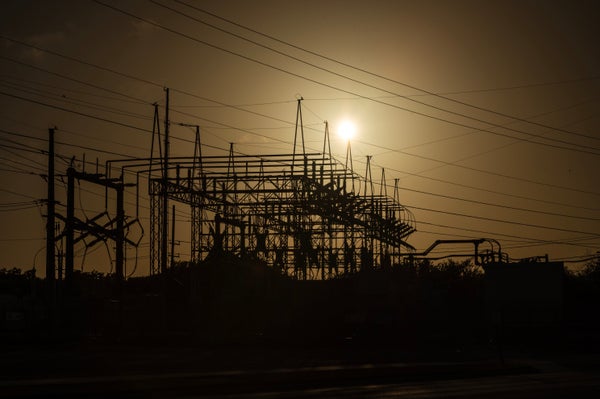CLIMATEWIRE | A battery boom is helping to stabilize the Texas power grid, offering a template for utilities that want to cut their greenhouse gases even as air conditioners hum wildly during heat waves.
The growth of batteries was evident last week when energy storage facilities injected a record amount of power into Texas’ electric system. It was badly needed on an evening when the state’s primary grid operator had called on consumers to conserve energy.
“I think it's a really big deal. I think it's underappreciated and under-talked about at this point,” said Doug Lewin, an Austin, Texas-based energy consultant who authors the Texas Energy and Power Newsletter. Without batteries, he said, “I think it's likely that on Thursday night, we would have been in the emergency conditions.”
On supporting science journalism
If you're enjoying this article, consider supporting our award-winning journalism by subscribing. By purchasing a subscription you are helping to ensure the future of impactful stories about the discoveries and ideas shaping our world today.
Texas has been at the center of a national debate over how to green the grid without jeopardizing reliability. The region has been battered in recent years by extreme weather events as the state's power sector has undergone large changes, with coal generation falling rapidly and renewable production climbing quickly. Solar, in particular, has helped Texas navigate a prolonged heat wave this summer.
Batteries represent the next chapter in Texas’ evolution because they stabilize the grid in the evening, when energy demand is high and solar generation plummets. Texas has installed 2.5 gigawatts of battery capacity over the last five years — about a quarter of total U.S. battery capacity. Only California has installed more.
A scorching summer has put Texas’ new battery fleet to the test. The Austin area has recorded 44 consecutive days of temperatures in excess of 100 degrees Fahrenheit. Dallas is in the middle of a 19-day streak of temperatures above 105 F.
The searing heating has sent Texans rushing for relief. The use of air conditioners, coupled with population growth, has shattered records for power demand. The Electric Reliability Council of Texas, which runs the power grid serving 90 percent of the state, said Sunday it has broken its record for power demand 10 times this summer.
Grid conditions got particularly tight Thursday, when ERCOT urged residents to conserve electricity between 3 p.m. and 8 p.m. due to high temperatures, elevated power demand and weak wind energy generation, which often picks up in the evening. Power prices surged to $5,000 per kilowatt-hour, the maximum amount allowed by ERCOT.
That’s when the batteries stepped in. They discharged 1.8 GW of power onto the grid and sent power prices falling to around $2,700 per megawatt-hour.
“It is like two nuclear power plants worth of support for the grid,” said Michael Webber, a professor at the University of Texas, Austin, who studies the power system. “That comes in really handy when you've got scarce conditions, high prices, a power shortfall, that kind of thing.”
Batteries have the advantage of being easy to build, he added, noting that most of Texas’ capacity has been brought online in the last two years.
“It's just a phenomenal kind of scale you can get very cheaply,” Webber said. “They're just so much smaller and cheaper to install than a massive power plant. And they really help us get better economics out of the grid, because they can buy power when there's excess power and then discharge power when there's scarcity.”
Most of the energy storage facilities rely on lithium-ion batteries, similar to those used in electric cars, cellphones or laptops. They typically discharge power for up to four hours and can recharge over the course of a day.
That makes them ideally suited during periods of peak demand, like those in Texas, but less useful for addressing seasonal reductions in renewable output, said Sam Newell, who leads the electricity practice at the Brattle Group, a consulting firm.
Even so, lithium-ion batteries have important implications for greening the grid, he said.
“If every single day you're meeting the evenings with storage, discharging instead of firing up fossil fire resources, that would reduce emissions,” he said.
In California, batteries have played a particularly important role during nighttime hours, when the state typically leans on natural-gas-fired power plants. The California Independent System Operator has set 10 records for battery production this summer, according to GridStatus. The current record is 4.2 GW recorded on Aug. 14 at 10 p.m.
Yet battery installations outside Texas and California are limited. Florida ranks third for battery capacity nationwide with 558 megawatts installed to date, according to the U.S. Energy Information Administration.
Analysts say battery installations have raced forward in California and Texas due to the high level of solar generation in both states. That is because solar energy production creates a relatively predictable pattern in electricity prices, with prices falling during the day and climbing during the evening.
“They're just ahead in the fundamentals that make storage valuable. The others will get there,” Newell said.
Reprinted from E&E News with permission from POLITICO, LLC. Copyright 2023. E&E News provides essential news for energy and environment professionals.
